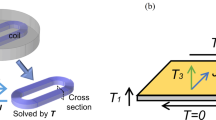Abstract
High-temperature superconducting (HTS) magnet, due to its greater performance of magnetic field at higher temperature (20–40 K), better thermal stability, smaller volume and weight under the same requirements, and lower refrigeration costs, has attracted growing attention in the ultra-high-speed maglev system, high field magnet, and some other applications. Considering the practical requirements, closed-loop method is generally adopted in HTS magnet to maintain the persistent operation and to output the stable magnetic fields. But the accelerated current attenuation occurs when the HTS magnet is subjected to traveling magnetic fields, which is not conducive to the long-term operation. Therefore, this paper aims to investigate the essence of current attenuation of HTS magnet in persistent current mode under traveling magnetic fields and to further suppress this adverse behavior. In this study, to calculate the current distribution and dynamic resistance, a two-dimensional (2-D) finite element model (FEM) was established and verified by comparing with the experimental results. It can be seen from the simulation results that the dissipative losses caused by dynamic resistance present a non-negligible effect on the current attenuation of the magnet. And the mechanism of faster current attenuation was well explained by the variation of the dynamic resistance under the traveling magnetic fields.







Similar content being viewed by others
References
Mizuno, K., Sugino, M., Tanaka, M., Ogata, M.: IEEE Trans. Appl. Supercond. 27, 3600205 (2017)
Ogata, M., Mizuno, K., Arai, Y., Hasegawa, H., Sasakawa, T., Nagashima, K.: IEEE Trans. Appl. Supercond. 21, 1556–1559 (2011)
Dong, F., Huang, Z., Hao, L., Xu, X., Jin, Z., Shao, N.: Sci. Rep. 9, 11844 (2019)
Yokoyama, S., Lee, J., Imura, T., Matsuda, T., Eguchi, R., Inoue, T., Nagahiro, T., Tanabe, H., Sato, S., Daikoku, A., Nakamura, T., Shirai, Y., Miyagi, D., Tsuda, M.: IEEE Trans. Appl. Supercond. 27, 4400604 (2017)
Hahn, S., Kim, K., Kim, K., Hu, X., Painter, T., Dixon, I., Kim, S., Bhattarai, K.R., Noguchi, S., Jaroszynski, J., Larbalestier, D.C.: Nature. 570, 496–499 (2019)
Liu, J., Wang, Q., Qin, L., Zhou, B., Wang, K., Wang, Y., Wang, L., Zhang, Z., Dai, Y., Liu, H., Hu, X., Wang, H., Cui, C., Wang, D., Wang, H., Sun, J., Sun, W., Xiong, L.: Supercond. Sci. Technol. 33, 03LT01 (2020)
Takahashi, K., Hase, T., Awaji, S., Nakai, A., Yamano, S., Mukoyama, S., Sakamoto, H.: IEEE Trans. Appl. Supercond. 28, 4600104 (2018)
Ohki, K., Nagaishi, T., Kato, T., Yokoe, D., Hirayama, T., Ikuhara, Y., Ueno, T., Yamagishi, K., Takao, T., Piao, R., Maeda, H., Yanagisawa, Y.: Supercond. Sci. Technol. 30, 115017 (2017)
Park, Y.G., Lee, C.Y., Lee, J., Nam, S., Chung, Y.D., Yoon, Y.S., Ko, T.K.: IEEE trans. Appl. Supercond. 25, 3601204 (2015)
Geng, J., Zhang, H., Li, C., Zhang, X., Shen, B., Coombs, T.A.: Supercond. Sci. Technol. 30, 035022 (2017)
Oomen, M.P., Rieger, J., Leghissa, M., Haken, B., Kate, H.H.J.t.: Supercond. Sci. Technol. 12, 382–387 (1999)
Ogasawara, T., Yasukōchi, K., Nose, S., Sekizawa, H: Cryogenics, 16, (1) 33–38 (1976)
Ogasawara, T., Yasukōchi, K., Nose, S., Sekizawa, H.: Cryogenics 16, (2) 89–96 (1976)
Geng, J., Matsuda, K., Fu, L., Fagnard, J.-F., Zhang, H., Zhang, X., Shen, B., Dong, Q., Baghdadi, M., Coombs, T.A.: J. Phys. D. Appl. Phys. 49, 11LT01 (2016)
Pardo, E., Kovác, J., Šouc, J.: IEEE Trans. Appl. Supercond. 23, 4701305 (2013)
Shen, B., Li, C., Geng, J., Zhang, X., Gawith, J., Ma, J., Liu, Y., Grilli, F., Coombs, T.A.: Supercond. Sci. Technol. 31, 075005 (2018)
Zhang, M., Yuan, W., Kvitkovic, J., Pamidi, S.: Supercond. Sci. Technol. 28, 115011 (2015)
Kim, Y.B., Hempstead, C.F., Strand, A.R.: Phys. Rev. Lett. 9, 306–309 (1962)
Gömöry, F., Vojenčiak, M., Pardo, E., Solovyov, M., Šouc, J.: Supercond. Sci. Technol. 23, 034012 (2010)
Duron, J., Grilli, F., Dutoit, B., Stavrev, S.: Physica C. 401, 231–235 (2004)
Ainslie, M.D., Bumby, C.W., Jiang, Z., Toyomoto, R., Amemiya, N.: Supercond. Sci. Technol. 31, 074003 (2018)
Jiang, Z., Toyomoto, R., Amemiya, N., Zhang, X., Bumby, C.W.: Supercond. Sci. Technol. 30, 03LT01 (2017)
Funding
This work was supported in part by the National Natural Science Foundation of China under Grants 51722706, in part by the Sichuan Youth Science & Technology Foundation under Grants 2020YFG0354, in part by the State Key Laboratory of Traction Power under Grants 2019TPL_T12.
Author information
Authors and Affiliations
Corresponding author
Additional information
Publisher’s note
Springer Nature remains neutral with regard to jurisdictional claims in published maps and institutional affiliations.
Rights and permissions
About this article
Cite this article
Wang, R., Wang, C., Deng, Y. et al. The Underlying Mechanism of Faster Current Attenuation of HTS Magnet in Persistent Current Mode Subject to the Traveling Magnetic Fields. J Supercond Nov Magn 34, 27–36 (2021). https://doi.org/10.1007/s10948-020-05671-3
Received:
Accepted:
Published:
Issue Date:
DOI: https://doi.org/10.1007/s10948-020-05671-3




